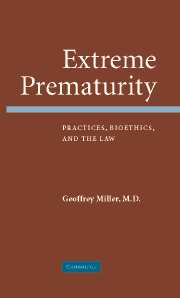Book contents
- Frontmatter
- Contents
- Part 1 THE EXTREMELY PRETERM INFANT: EPIDEMIOLOGY, PERCEPTIONS, AND PRACTICES
- Part 2 BIOETHICS
- Part 3 REPORTS, OFFICIAL OPINIONS, AND GUIDELINES
- 23 United States
- 24 Canada
- 25 United Kingdom (UK)
- 26 France
- 27 Italy
- 28 Germany
- 29 International
- Part 4 THE LAW
- Part 5 EPILOGUE: TRUTH, TRUST, AND BOUNDARIES
- References
- Index
23 - United States
Published online by Cambridge University Press: 23 September 2009
- Frontmatter
- Contents
- Part 1 THE EXTREMELY PRETERM INFANT: EPIDEMIOLOGY, PERCEPTIONS, AND PRACTICES
- Part 2 BIOETHICS
- Part 3 REPORTS, OFFICIAL OPINIONS, AND GUIDELINES
- 23 United States
- 24 Canada
- 25 United Kingdom (UK)
- 26 France
- 27 Italy
- 28 Germany
- 29 International
- Part 4 THE LAW
- Part 5 EPILOGUE: TRUTH, TRUST, AND BOUNDARIES
- References
- Index
Summary
The first important U.S. report that related to the extremely preterm infant came from a president's commission published in 1983.(226) In the section on seriously ill newborns, the commission reported that between 1970 and 1980 the neonatal mortality rate almost halved and that this was the greatest proportional decrease in any decade since national birth statistics were first recorded in 1915. The decrease was “especially dramatic” in the very low birth weight (<1,500g) and the extremely low birth weight (<1,000g) infants, with 50% of the latter surviving (at that time) compared to less than 20% twenty years previously. However, they noted that there was a downside to this, as the survivors could be impaired. This, they stated, tested “the limits of medical certainty in diagnosis” and “raises profound ethical issues.” The commission attempted to provide ethical and legal guidelines in order to provide a framework for those in health care and the law. To aid them in this, testimony was provided by various experts. One such testimony came from Carole Kennon, a neonatal intensive care social worker, who stated that anguished parents “watching the suffering of an infant the size of an adult's hand – connected to awesome machinery and offered only distant prospects of a somewhat normal survival – inevitably takes an emotional toll”; and for those families who leave the unit with a handicapped child: “they must often travel a financially and emotionally perilous path.”
- Type
- Chapter
- Information
- Extreme PrematurityPractices, Bioethics and the Law, pp. 91 - 105Publisher: Cambridge University PressPrint publication year: 2006



